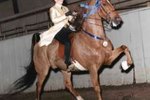
Cantering, or galloping, on a horse is a fun and thrilling experience once you know what you must do to ride safely. Novice riders may unknowingly tense up when unprepared for the sudden movement forward, but it is important to relax and maintain control of your entire body so as not to give the horse any wrong cues. Before you giddyup, you must have balance and core strength to canter with confidence.
Step 1
Wear a helmet and closed-toe hard-sole shoes. Begin at a trot when already in a faster, forward motion than the walk, on a horse you trust at this gait. Look out toward the path ahead, even if in an arena.
Step 2
Start to cue the canter by sitting when you would normally rise on the trot. Gently tap your lower legs against the horse's belly, just behind the girth of the saddle, which encourages the horse to continue moving forward. Do not squeeze with your lower legs.
Step 3
Remain seated in the saddle with a straight posture. Ease your weight off the back of the horse by putting more weight into your thighs and the stirrups, keeping your heels down. Do not lean forward too much or you could lose your seat.
Step 4
Use the reins concurrently with leg and weight cues. Keep the reins low with relaxed arms, following the movement of the horse's head rather than your own back and forth motion. Do not pull back hard on the reins, but instead give the horse enough room to stretch his head forward comfortably.
Step 5
Allow your hips to move with the horse's movement, once in motion, but keep your back straight and tall.
Step 6
Return to a posting trot, rising up and down in the saddle, if corrections for an unbalanced or overly fast canter are needed. Switch back and forth between the trot and canter to get better acquainted with the motion or when training a horse to canter.
References
Tips
- In an arena with an experienced rider on hand, try cantering with your feet out of the stirrups to improve your balance and seat.
Warnings
- Young horses are not strong enough to sustain a canter. Do not force him to canter any longer than he can.
Photo Credits
-
George Doyle/Stockbyte/Getty Images
Writer Bio
Pam Smith has been writing since 2005. In addition to her work for Demand Media, her articles have been published online at CBS Local. She also wrote for the Pennsylvania Center for the Book's Literary Map while earning a Bachelor of Arts degree in English at the Pennsylvania State University. She is currently an editorial assistant for Circulation Research.




